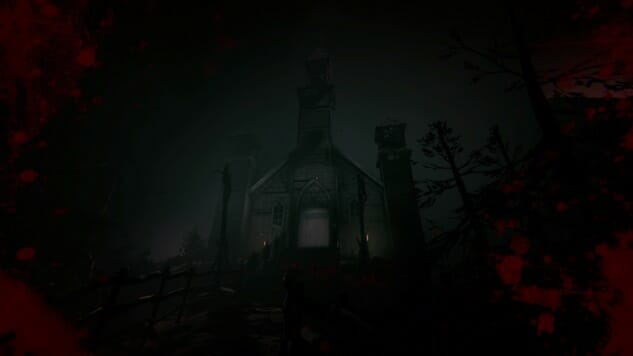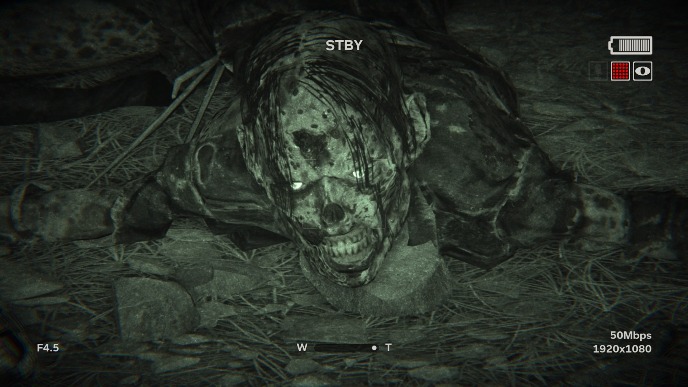Don’t Be Fooled By Outlast 2

Don’t be fooled by Outlast 2. Its plays on Catholicism, sex and family do not constitute a sophisticated or brave videogame. Its screaming enemies, dark levels and floods of gore are neither scary nor deliberately daft—it isn’t serious, or sincere. The game looks good and plays smoothly, but so does everything, of a similar budget and staff, these days. Attention to technical achievement and celebration of effort have long been Alamos to which the makers of bad games, or their charitable fans, could repair: in honor of Outlast 2, destroy them.
After our helicopter crashes in the Arizona desert, we, as Blake Langermann, husband and cameraman to television news reporter Lynn, must run, hide and film to avoid being murdered by either of two religious groups. The first believes in God. Puritanical and flagellant, they fear Lynn is pregnant with the anti-Christ, that Blake is the father and all three need to be killed to prevent the apocalypse. The second worships Satan and wants to capture Lynn so the child, their Messiah, may be safely born—exactly why they want to kill Blake is unclear.
Like in the first Outlast, and far more than the under-developed, barely on-screen Lynn, our closest friend is a hand-held camera, the microphone and night-vision functions of which help us evade enemies. To implausible, contrived extent, and despite making our protagonist appear suicidal, we cannot collect weapons and fight our pursuers. Instead, we run them in circuits around tables, hide inside cupboards and oil drums and submerge ourselves in troughs of rainwater—if Outlast 2’s creators are concerned that players slashing, stabbing and killing make a videogame look immature, or lessen its suspense, this generally comical process of hide and seek should have given them more cause for concern.

There are good moments—catching in our camera’s NV mode a pair of fluorescent green glowing eyes, swelling larger as its owner approaches, remains a striking image—but if not by design then via design, the game is less scary, more tedious. Levels are large and have multiple areas for exploration, but only one route for escape. Rather than relying on our wits, and thanks to a very forgiving checkpoint system, we overcome enemies using trial and error. Such is Outlast 2’s most damaging contradiction. By taking our weapons and placing us, often, in diffuse arenas with many places to hide, it suggests we use our minds and skills to succeed; by providing ultimately but one means for survival, one right door we must open, one right wall we must climb, one right lever to turn, it precludes any initiative. In short, despite its aesthetic implying otherwise, the most effective way to progress in Outlast 2 is to run around, in full view of enemies, until happening across the only correct exit. Rather than potential openings, the game’s big areas are misused to provide narrative exposition.
Outlast 2 seamlessly transitions between sequences in the Arizona desert and flashbacks to Blake’s childhood at Catholic school. Its most graceful and truly disorientating moments see us squeeze out of a pothole, or open the door of a wooden shack, and emerge suddenly into a bright, clean high school from the mid 1990s—regarded in isolation, these cuts make Outlast 2’s story seem almost economical. But the game is nonsense. If the first Outlast used mental illness as both singular explanation and vector for its frightful set pieces, Outlast 2 uses faith: the enemies are vicious, deformed, occasionally supernatural and capable of intensely creative violence and dismemberment, and the only given context is “they are religious extremists.” If not callous, it’s certainly lazy—little effort seems to have been expended creating these antagonists, making them impossible to respect, and thus hard to find scary.

Blake might be killed by having his penis hacked off, or by an apparition which impales him using its tongue—other enemies call one another “festering shits” and “dog’s cunt.” Blood and corpses are applied like wallpaper. And if Outlast 2 weren’t so overwrought, and didn’t place these moments immediately together, or keep using Blake to stress how shocked we should be (he’s constantly yelling “oh my God!” or “this is fucking crazy!”) we might enjoy it for a willing, grisly exploitation game. But what might pass, in a game with even a shred of a sense of humor, as playful effectuation comes over here as painfully earnest. Its makers seem genuinely convinced that piles of virtual bodies should terrify us to our core—hundreds of YouTubers, screeching on demand over their videos of the first Outlast, probably didn’t help. Combined with how it bullies and tosses aside Lynn, and, in the sense it has nothing cogent or convicted to say about any of them, makes only token references to religion, rape and child abuse, Outlast 2 is a roundly joyless game. It neither grapples wholeheartedly with its characters and subject matter nor takes pleasure from toying with them. One is reticent to use the word because it sounds aloof, and like a deliberate effort to ignore or downplay a videogame’s better qualities. But Outlast 2 is gibberish, and miserable gibberish at that.
Instead of scary, it’s slapstick. Rather than provocative, it’s numbing—game-makers in general are yet to attack this problem, but as soon as you’ve died and come back in Outlast 2 its ability to scare is all but gone. Arguably, the game’s chief shortcoming is an adherence to vogue. At some point, it was decided horror games were more effective if they didn’t involve combat; since then, they’ve flailed looking for ways to fill a now empty space, and a groundswell of aspiration, toward making videogames broadly about more than murdering for reward, has emboldened them. However, if the creators of horror games have silently, collectively agreed to redefine a genre, Outlast 2, packed with nonsense plot, engorged levels and frantic, anonymous bloodshed, feels like the definitive failure of their ambition. Don’t be fooled by it, or its intent.
Outlast 2 was developed by Red Barrels. Our review is based on the PS4 version. It is also available for Xbox One and PC.
Ed Smith is a writer from the UK. You can follow him on Twitter @mostsincerelyed and find more of his work at bulletpointsmonthly.com.